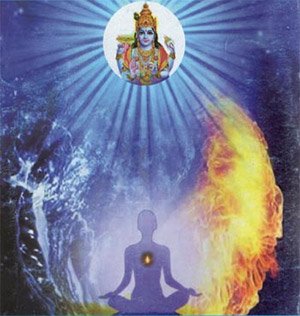Siddhanta Sangraha of Sri Sailacharya
by E. Sowmya Narayanan | 2008 | 30,562 words
Siddhanta Sangraha Chapter 6 (English translation), entitled “the gross elements” as included in the critical edition and study. The Siddhanta Samgraha is a Sanskrit philosophical text dealing with Vishishtadvaita in five hundred Sanskrit verses. It was written by Shri Shailacarya (18th century) and closely follows the philosophy of Vedanta Deshika (13th century).
Chapter 6 - The Gross elements
41. From the tāmasāhaṃkāra evolves out the subtle element called śabdatanmātra. From the śabdatanmātra originate Ether and from it the sparśatanmātra.
42. From the sparśatanmātra evolves out Vāyu and from it the rūpatanmātra. From the rūpatanmātra originates tejas and from it rasatanmātra.
43. From rasatanmātra originates Waters, from which the gandhatanmātra. From the gandhatanmātra the earth is produced. This is the order of Creation.
44. The statement that there are eight prakṛtis and their modifications are sixteen is to confirm only this order of Creation.
45-46. The eight prakṛtis are avyakta, mahān, ahaṃkāra and the five tānmātras [tanmātras?]. The eleven sense organs and the five gross elements are the sixteen modifications.[1]
47. The scriptural statement that the Vāyu originated from Ākāśa etc. is with the view that it originated from its respective subtle elements (tanmatras). The above statement is made because the subtle elements of ether, wind etc., thus possesses those characteristic features of sound, touch etc.
48. As these characteristic features are not fully manifested, and as they are present in a latent form, the statement is correct only. The familiar statement such as Vāyu originated from Ākāśa was colloquel [colloquial?].
49-50. The expression buta coined to the tanmātras seemed to be acceptable to the great preceptors. The statement of the Tamil prabandha that the two butas represent the two garlands in the beatific form of the Lord is the view of Śrī Vedānta Deśika.[2] The above statement is mentioned by Śrī Kumāravaradācārya in the text Tattvatrayaścintanā.
51-52. The eight categories commencing from auyakta are to be known only by the śāstras. As they are beyond sense perceptions and inferential knowledge they are to be known only by the śāstras. Ether has sound alone as its quality as it is clearly manifested in it Though it is bigger than Vāyu and others yet it is accepted to be limited.
53. Thus Ether is produced, is accepted on the scriptural authority which declares that ether, wind, light, etc., are produced. Therefore Ether is not eternal.
Footnotes and references:
[1]:
See Sāṅkhya Kārikā - 3
[2]:
See Adhikāra Saṅgraha, verse. 41.
Puruḍan maṇivaramāha ponnāmulap
Prakṛtimaruvaga mān tandagat
Terul marul vālmaraivaga āngarangal
Sarganjsangāga manantigiriyāga
Iruḍigangalīraindum sarangalaga
Irubhūtamālai vanamālaiyāga
Garudanuruvām maraiyin porulām kannan
Karigirimel ninranitthum kākkinrāne ||
Conclusion:
 This concludes The Gross elements according to Vishishtadvaita philosophy explained by Shri Shailacarya. This book follows the model of Vedanta Deshika although the Vishishta Advaita school was originally expounded by Shri Ramanuja. Vishishta-Advaita is one of the various sub-schools of Vedanta which itself represents one of the six orthodox schools of Hindu Philosophy. They highlight the importance of the Upanishads, the Bhagavad Gita and the Brahma Sutras.
This concludes The Gross elements according to Vishishtadvaita philosophy explained by Shri Shailacarya. This book follows the model of Vedanta Deshika although the Vishishta Advaita school was originally expounded by Shri Ramanuja. Vishishta-Advaita is one of the various sub-schools of Vedanta which itself represents one of the six orthodox schools of Hindu Philosophy. They highlight the importance of the Upanishads, the Bhagavad Gita and the Brahma Sutras.
